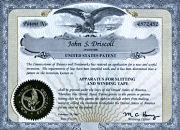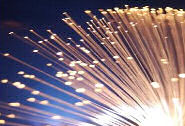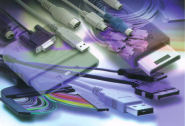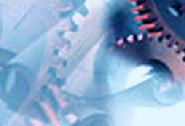OUR DISCIPLINES — Patents
We find the best solutions—even if we have to invent them. Our team of engineers have received more than 35 domestic and international patents.

Patent #4,925,353: DRIVE FASTENING SYSTEM
Abstract:
A fastening system for securing an article to a base uses a conventional drive fastener. A reaction surface on the article contacts the bearing surface on the underside of the fastener head causing the fastener head to tilt relative to the body of the fastener. The reaction surface also causes the body of the drive fastener to deform when it is fully driven into the article, and a portion of the material from the reaction surface is displaced into the aperture to increase the retention force of the fastener.
Patent #5,098,306: CARD EDGE CONNECTOR WITH SWITCHING CONTACTS
Abstract:
A card edge connector having spring contacts that are partially movable by insertion of a circuit board into the connector. The contacts include two contacts that electrically contact each other when a circuit board is not connected to the connector. The two contacts are moved by insertion of a circuit board into the connector which results in disconnection of the electrical contact between the two contacts. This allows a signal contact to be contacted and grounded by a ground contact while the connector is not in use and, nonetheless allows independent ground and signal functions of the two contacts when a circuit board is connected to the connector.
Patent #5,396,402: APPLIANCE FOR ATTACHING HEAT SINK TO PIN GRID ARRAY
Abstract:
A device for attaching a heat sink to a chip having an integrated circuit and a pin grid array socket. The device includes a leaf spring pre-assembled to two plastic clips, each of the plastic clips containing a portion which is adapted to extend below the socket, thereby releasably securing the heat sink to the chip and the socket.
Patent #5,533,255: TOOL FOR REPAIR/REPLACEMENT OF ELECTRICAL CONNECTORS
Abstract:
The tool has a frame and a positioner. The frame has top and bottom guide rails that are suitably sized and located to be slidingly received in guide channels of a printed circuit board receiving cage. A locking latch is provided on the frame to stationarily, but removably latch the frame to the receiving cage. The positioner is movably attached to the frame and has a working head receiving area. The working head receiving area is adapted to removably mount any one of a plurality of working heads to the positioner. The positioner is adapted to move an attached working head to a desired location for inserting and/or removing an electrical contact in an electrical connector of the cage, or inserting and/or removing an electrical connector in the cage.
Patent #5,655,931: ELECTRICAL CONNECTOR, ELECTRICAL CONTACT AND HOUSING
Abstract:
An electrical connector for a printed circuit board having a housing and a combined electrical contact and housing mount assembly. The assembly has a first member and a second member. The first member passes through the housing. A ledge on the first member is located on a ledge of the housing. The second member is connected to the second member such that they can sandwich a portion of the printed circuit board there-between. The bottom of the first member extends past a bottom portion of the housing to make electrical contact with a contact pad on the printed circuit board.
Patent #5,997,361: ELECTRONIC CABLE CONNECTOR
Abstract:
An electrical cable connector is disclosed for connecting a plurality of electrical conductors to a printed circuit board. The cable connector includes a cable socket connector having a plurality of female insulation displacement contacts which can be mated with male signal-carrying pins contained in a pin shroud on a printed circuit board. The cable socket connector is comprised of a hood which retains two or more wafers. Each wafer contains a plurality of insulation displacement contacts. The cable socket connector may include a latch for securing the cable socket connector to the pin shroud and shielding to prevent extraneous signals from being transmitted into the circuits on the printed circuit board through the cable connector. The cable connector also includes an arrangement for keying the cable socket connector to the pin shroud to control the location of insertion of the cable socket connector into the pin shroud.
Patent #6,179,663: HIGH DENSITY CONNECTOR WITH CROSSTALK REDUCTION
Abstract:
Disclosed is an electrical interconnect system using multiple grounding methods to reduce or prevent spurious signals from interfering with high density contacts carrying high speed transmissions. A first connector includes an insulative pillar partially surrounded by a plurality of signal contacts. A ground contact is at least partially located within the insulative pillar. A second connector includes a corresponding plurality of flexible signal contacts for mating with the signal contacts adjacent the insulative pillar. The second connector also includes a ground contact for receiving the ground contact of the first connector. The ground contacts provide a first method of providing a ground path to reduce spurious signals from entering the signal path. An electrically conducting shield is located outside the signal contacts when the first and the second connectors are mated. The first connector includes a member which provides a ground path between the first connector and the electrically conducting shield. Advantageously, the electrical interconnect system has two grounding methods which are particularly important in a high density electrical interconnect system where the contacts are closely spaced and susceptible to noise and other spurious signals.
Patent #6,206,729: HIGH DENSITY ELECTRICAL INTERCONNECT SYSTEM
Abstract:
Disclosed is an electrical interconnect system using multiple grounding methods to reduce or prevent spurious signals from interfering with high density contacts carrying high speed transmissions. A first connector includes an insulative pillar partially surrounded by a plurality of signal contacts. A ground contact is at least partially located within the insulative pillar. A second connector includes a corresponding plurality of flexible signal contacts for mating with the signal contacts adjacent the insulative pillar. The second connector also includes a ground contact for receiving the ground contact of the first connector. The ground contacts provide a first method of providing a ground path to reduce spurious signals from entering the signal path. An electrically conducting shield is located outside the signal contacts when the first and the second connectors are mated. The first connector includes a member which provides a ground path between the first connector and the electrically conducting shield. Advantageously, the electrical interconnect system has two grounding methods which are particularly important in a high density electrical interconnect system where the contacts are closely spaced and susceptible to noise and other spurious signals.
Patent #6,743,049: High Speed, High Density Interconnection Device
Abstract:
An intercoupling component for receiving an array of contacts within a digital or analog transmission system having an electrical ground circuit and chassis ground circuit, the intercoupling component may include a segment formed of electrically insulative material and having an upper and lower surface, the segment including a plurality of holes disposed on its upper surface and arranged in a predetermined footprint, one or more a shield members formed of electrically conductive material disposed within the segment and configured to connect to the chassis ground circuit of the system and a frame formed of electrically conductive material and configured to connect with the chassis ground circuit of the system. The intercoupling component may include an array of electrically conductive contacts grouped to multi-contact groupings configured to transmit single-ended or differential signals. The intercoupling component may include a cavity located between signal contacts to adjust the differential impedance between signal contacts.
Patent #6,899,550: High Speed, High Density Interconnection Device
Abstract:
An intercoupling component for receiving an array of contacts includes a non-conductive substrate having a plurality of holes disposed on its upper surface and arranged in a predetermined footprint corresponding to the array of contacts. Contacts are disposed within the holes and a cavities, which may be open to air or filled with some other dielectric material, are disposed in the substrate between adjacent contacts.
Patent #7,021,945: High Speed, High Density Interconnection Device
Abstract:
An intercoupling component for receiving an array of contacts within a digital or analog transmission system having an electrical ground circuit and chassis ground circuit, the intercoupling component including a segment formed of electrically insulative material and having an upper and lower surface, the segment including a plurality of holes disposed on its upper surface and arranged in a predetermined footprint and one or more a shield members formed of electrically conductive material disposed within the segment and configured to connect to the chassis ground circuit of the system. The intercoupling component may include an array of electrically conductive contacts within the plurality of holes disposed on the segment. One or more of these contacts may be configured to electrically connect with the electrical ground circuit of the system. The intercoupling component may also include a cavity located between signal contacts to adjust the differential impedance between signal contacts.
ist gets it done!




